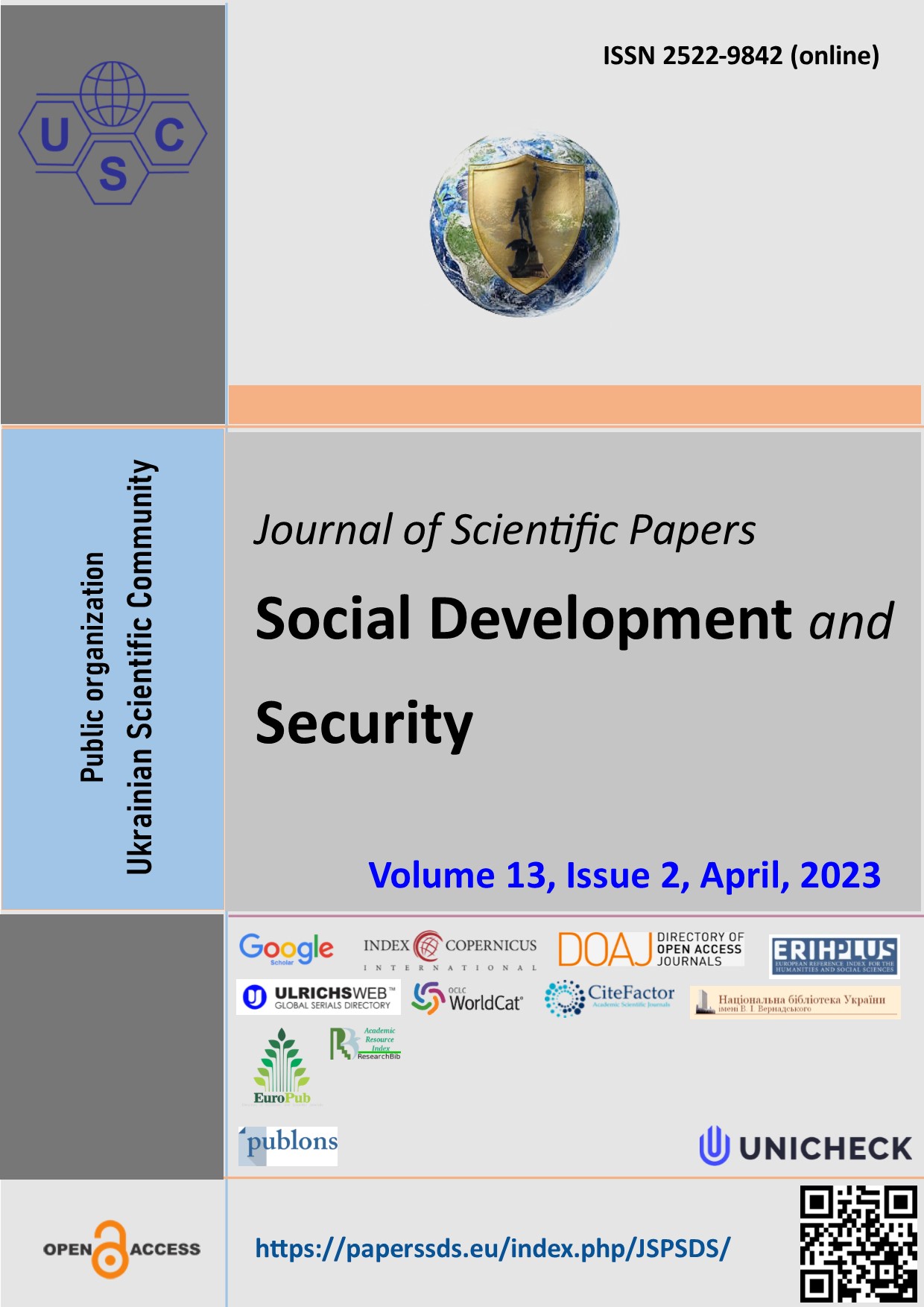Prevention of occupational risks and reduction of harmful effects on the occupational health of workers of metallurgical waste components
Abstract
Purpose: is identification and analysis of risks from harmful factors associated with the generation and storage of man-made waste, as well as ways to eliminate them.
Approach: a risk-oriented approach was used as the main research approach.
Findings: identified and analyzed risks for employees of metallurgical enterprises and residents of nearby territories from harmful factors associated with the generation and storage of man-made waste from metallurgical production. It is determined how it is possible to avoid harmful factors or reduce their effect.
Practical implications: measures for the storage and processing of man-made metallurgical waste aimed at minimizing the risk of their harmful effects are proposed.
Value: a complex graphic diagram of the cause-and-effect relationship between the methods of handling man-made metallurgical waste of various types and the risks of exposure to harmful factors was built, with the indication of the most rational ways of handling.
Future research: the development of future research is possible in the direction of expanding the used risk assessment methods.
Paper type: descriptive and analytical.
Downloads
References
Puchol, R. Q., Sosa, E. R., González, L. O., Castañeda, Y. P., Sierra, L. Y. (2016). New conception of the reutilization of solid waste from Cuban nickeliferous hydrometallurgical industry. Centro Azúcar Journal, 43, 4, 1–15.
Grigor’ev, S. M., Petrishchev, A. S. (2012). Assessing the phase and structural features of the scale on p6m5ф3 and p12m3k5ф2 steel. Steel in Translation, 42, 3, 272–275. https://doi.org/10.3103/S0967091212030059
Poliakov, A., Dzyuba, A., Volokh, V., Petryshchev, A., Tsymbal, B., Yamshinskij, M., Lukianenko, I., Andreev, A., Bilko, T., Rebenko, V. (2021). Identification of patterns in the structural and phase composition of the doping alloy derived from metallurgical waste processing. Eastern-European Journal of Enterprise Technologies, 12 (110), 2, 38–43. https://doi.org/10.15587/1729-4061.2021.230078
Pincovschi, I., Neacsu, N., Modrogan, C. (2017). The adsorbtion of lead, copper, chrome and nickel ions from waste waters in agricultural argilaceous soils. Revista de Chimie, 68, 4, 635–638. https://doi.org/10.37358/RC.17.4.5520
Madebwe, V., Madebwe, C., Munodawafa, A., Mugabe, F. (2017). Analysis of the spatial and temporal variability of toxic heavy metal concentrations in ground water resources in upper sanyati catchment, Midlands Province, Zimbabwe. IIARD International Journal of Geography and Environmental Management, 3, 1, 23–37.
Briffa, J., Sinagra, E., Blundell, R. (2020). Heavy metal pollution in the environment and their toxicological effects on humans. Heliyon, 6, 9. https://doi.org/10.1016/j.heliyon.2020.e04691
Tsymbal, B., Petryshchev, A., Andrieieva, L., Sharovatova, O. (2022). Improving occupational safety and health in the processing of metallurgical waste and features of their microstructure transformation. Key Engineering Materials, 925, 187–196. https://doi.org/10.4028/p-f9x0w1
Schlögl, S., Diendorfer, P., Baldermann, A., Vollprecht, D. (2023). Use of industrial residues for heavy metals immobilization in contaminated site remediation: a brief review. International Journal of Environmental Science and Technology, 20, 2313–2326. https://doi.org/10.1007/s13762-022-04184-x
Yu, J., Jiang, Ch.,Guan, Q.,Ning, P.,Gu, J.,Chen, Q.,Zhang, J.,Miao, R. (2023). Enhanced removal of Cr(VI) from aqueous solution by supported ZnO nanoparticles on biochar derived from waste water hyacinth. Chemosphere, 195, 632–640. https://doi.org/10.1016/j.chemosphere.2017.12.128
Ishchenko, V. Environment contamination with heavy metals contained in waste. (2018). Environmental Problems, 3, 1, 21–24.
Hryhoriev, S., Petryshchev, A., Sinyaeva, N., Yurchenko, A., Sklyar, O., Kvitka, S., Borysov, V., Vlasiuk, V., Tsymbal, B., Borysova, S. (2018). Studying the physicalchemical properties of alloyed metallurgical waste as secondary resourcesaving raw materials. Eastern-European Journal of Enterprise Technologies, 12 (94), 4, 43–48. https://doi.org/10.15587/1729-4061.2018.140924
Hryhoriev, S., Petryshchev, A., Belokon’, K., Krupey, K., Yamshinskij, M., Fedorov, G., Stepanov, D., Semenchuk, A., Matukhno, E., Savvin, A. (2018). Determining the physical-chemical characteristics of the carbon-thermal reduction of scale of tungsten high-speed steels. Eastern-European Journal of Enterprise Technologies, 6 (92), 2, 10–15. https://doi.org/10.15587/1729-4061.2018.125988.
Petryshchev, A., Braginec, N., Borysov, V., Bratishko, V., Torubara, O., Tsymbal, B., Borysova, S., Lupinovich, S., Poliakov, A., Kuzmenko, V. (2019). Study into the structural-phase transformations accompanying the resource-saving technology of metallurgical waste processing. Eastern-European Journal of Enterprise Technologies, 12 (100), 4, 37–42. . https://doi.org/10.15587/1729-4061.2019.175914
Petryshchev, A., Milko, D., Borysov, V., Tsymbal, B., Hevko, I., Borysova, S., Semenchuk, A. (2019). Studying the physical-chemical transformations at resourcesaving reduction melting of chromenickel-containing metallurgical waste. Eastern-European Journal of Enterprise Technologies, 12 (98), 2, 59–64. https://doi.org/10.15587/1729-4061.2019.160755
Abstract views: 242 PDF Downloads: 173
Copyright (c) 2023 Bohdan Tsymbal, Artem Petryshchev, Alexandr Malko

This work is licensed under a Creative Commons Attribution 4.0 International License.
The authors agree with the following conditions:
1. Authors retain copyright and grant the journal right of first publication (Download agreement) with the work simultaneously licensed under a Creative Commons Attribution License that allows others to share the work with an acknowledgment of the work's authorship and initial publication in this journal.
2. Authors have the right to complete individual additional agreements for the non-exclusive spreading of the journal’s published version of the work (for example, to post work in the electronic repository of the institution or to publish it as part of a monograph), with the reference to the first publication of the work in this journal.
3. Journal’s politics allows and encourages the placement on the Internet (for example, in the repositories of institutions, personal websites, SSRN, ResearchGate, MPRA, SSOAR, etc.) manuscript of the work by the authors, before and during the process of viewing it by this journal, because it can lead to a productive research discussion and positively affect the efficiency and dynamics of citing the published work (see The Effect of Open Access).
















